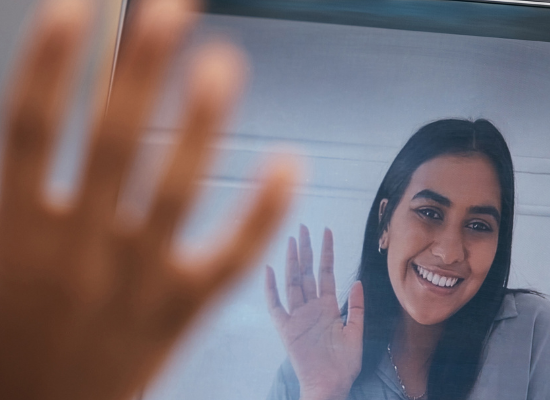
Stephanie Hepburn is a writer in New Orleans. She is the editor in chief of #CrisisTalk. You can reach her at .
Kevin Berthia is no stranger to stigma. Not just about mental health but discussing emotions, generally. “Growing up, we didn’t talk about feelings.” That created a barrier for him in identifying and processing emotions. “It was hard for me to understand I needed to work through them, let alone that emotions can help me navigate life.”
Not understanding his emotions compounded his challenges with mental health. “How could I address my mental health if I didn’t know how to deal with my feelings?”
Nearly two decades ago, at 22, Berthia climbed over the railing of the Golden Gate Bridge, intending to end his life. On the other side was Kevin Briggs, a highway patrol officer, who spoke with Berthia for 92 minutes and helped pull him back to safety. What Berthia found in Briggs was compassion and connection.
Today, Berthia is a suicide prevention advocate and founder of the Kevin Berthia Foundation.
He believes the Covid-19 public health emergency pushed society over a tipping point that increased compassion and chipped at stigma, helping to normalize mental health discussions. “The world was in the same fishbowl, and there’s never been a time in history where the entire world was in the same fishbowl,” he says. “Everybody got a taste of mental health challenges.”
Together, the pandemic and 988 — the SAMHSA-funded 988 Suicide and Crisis Lifeline (formerly the National Suicide Prevention Lifeline) — put mental health at the forefront in a way Berthia hasn’t seen before. However, the behavioral health care field is amid a workforce shortage. “More people are OK reaching out, but there aren’t enough providers to match their needs — that means we need to get creative.”
He points out that the pandemic and post-pandemic have gone hand-in-hand with long delays in getting an appointment with a therapist. “People are having to wait weeks, months,” he says. “We cannot afford that timeframe.” Dr. Thema Bryant, president of the American Psychological Association, echoed Berthia’s sentiments, telling Monitor on Psychology that while people were “giving themselves permission” to reach out to mental health services, many were “discouraged because nobody had openings.”
The behavioral health field is trying to come up with solutions but some stark realities must be addressed — there are fewer psychologists and psychiatrists. According to Psychiatric Services, there’s a projected shortage of between 14,280 and 31,091 psychiatrists. Workforce dearths are even more pronounced for youth-focused psychiatrists, with workforce maps for child and adolescent psychiatrists showing severe shortages in all states except for Massachusetts and Maine, which have high shortages and the average age for child and adolescent psychiatrists are in their fifties.
Mental Health America tracks people’s access to care, broken down by state. The 2023 report highlighted that, in the United States, there are 350 people to one mental health provider, including advanced practice nurses, counselors, licensed clinical social workers, marriage and family therapists, psychiatrists and psychologists. The best ratio is 140-to-1 and the worst is 850-to-1.
“It’s just wild to me,” laughs Berthia, “everyone wanted to be a therapist and no one was talking about mental health.” “Now everyone is talking about mental health and no one wants to be a therapist.”
In an effort to make the field more accessible, the American Psychological Association has called on psychologists to take a public health approach. To reach more people, some psychologists are doing shorter, single-session interventions. Among them is Dr. Jessica Schleider, a clinical psychologist and founder of the Lab for Scalable Mental Health. She told Monitor on Psychology that she and her colleagues have tested online, single-session interventions on social media for adolescents experiencing symptoms of depression.
Berthia shares this rapid, frequent approach can be used by anyone working in the behavioral field, including peers and others with lived experience. He chats with people he’s working with on the phone for 10-15 minutes. Then, he follows up later that day and the next morning.
He believes follow-up needs to be integrated into most behavioral health services and support settings. Research by Dr. Madelyn Gould has shown follow-up to be lifesaving for those who’ve reached out to the 988 Suicide and Crisis Lifeline. People are especially vulnerable in the weeks after a crisis.
However, Berthia believes that the timeframe while people are doing therapy, particularly at the beginning, is also a time of immense vulnerability. “These sessions have us open up, and it’s grueling work,” he says, “and then we walk around with all of that until the next week.”
Dr. Ursula Whiteside uses caring messages with her patients, sending them texts. In 2012, she founded NowMattersNow.org, a website that makes brief, effective crisis interventions accessible to people with internet access. In 2021, Whiteside shared with #CrisisTalk that anyone, not just mental health providers, can use caring messages to give another person support. The key, she says, is to support someone without demanding anything from the recipient.
Berthia highlights that follow-up and support can be personalized and lean on technology to ensure people don’t fall through the cracks. “Why not send outgoing check-in messages through text or social media?” he asks. While there are third-party apps that allow for direct messages to be scheduled, Berthia warns that offering support and following up should ensure they’re available at the time the check-in will go out, in case the person isn’t doing well.
“Follow-up and check-ins, online or by text, makes a massive difference in people’s lives,” he says. “It allows them to understand they’re valued and haven’t been forgotten about. People in a dark place want to be and feel connected. It’s one of the most critical suicide prevention tools.”
He points out that connection with another human helped save his life. That said, he believes federal and state leaders also need to understand how vital it is to decrease lethal means, including using safety netting on landmarks like the Golden Gate Bridge.
Since its construction, a four-foot-tall railing has been the only barrier on the Golden Gate Bridge stopping people from plunging into the chilly waters of the Golden Gate Strait below. In 2017, construction began on a safety net suicide deterrent system that’s expected to be completed by the end of 2023. Similar deterrents exist on other landmarks, including the Eiffel Tower and the Empire State Building.
Kay James, whose son Michael Bishop was one of the 37 people who died jumping off the bridge in 2011, told The San Francisco Standard that people continue to incorrectly believe that a person intent on ending their life will find a way to get around any barrier created to stop them. “I don’t think most people are aware of the importance of taking away lethal means of killing yourself,” she said.
“If the safety net had been on the bridge there that day, I would have immediately stopped,” says Berthia. “People who are at that point, we don’t have the energy. We’re tired.”
He says the public health emergency highlighted another safety net people need — community. “We don’t just need our family and friends but also our exchanges with the barista at Starbucks. It’s not the coffee we crave; it’s human interaction.”









